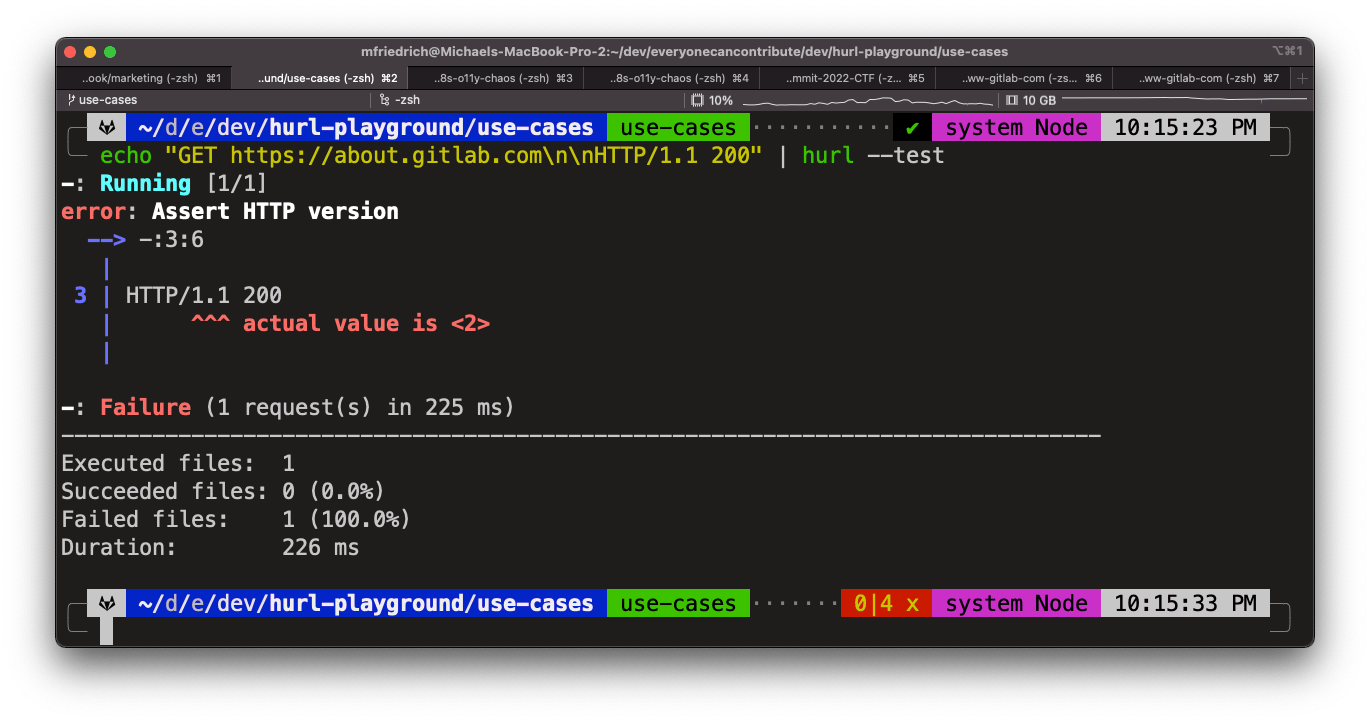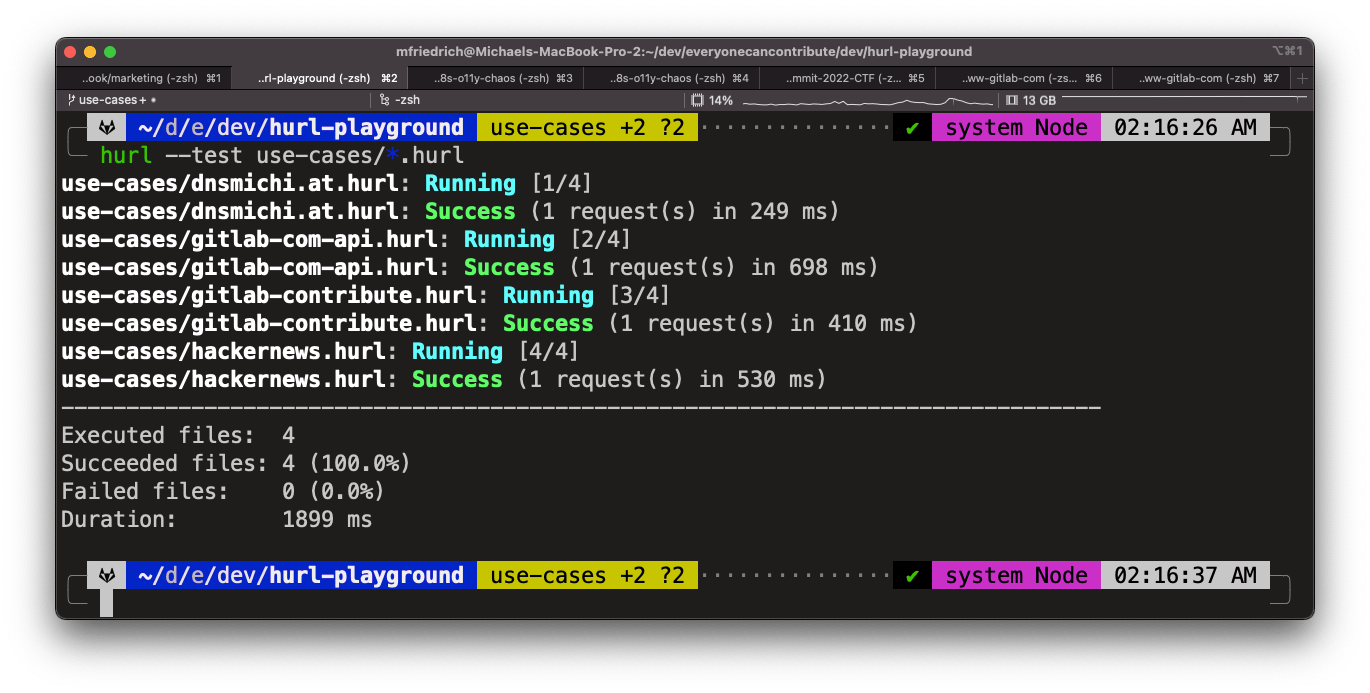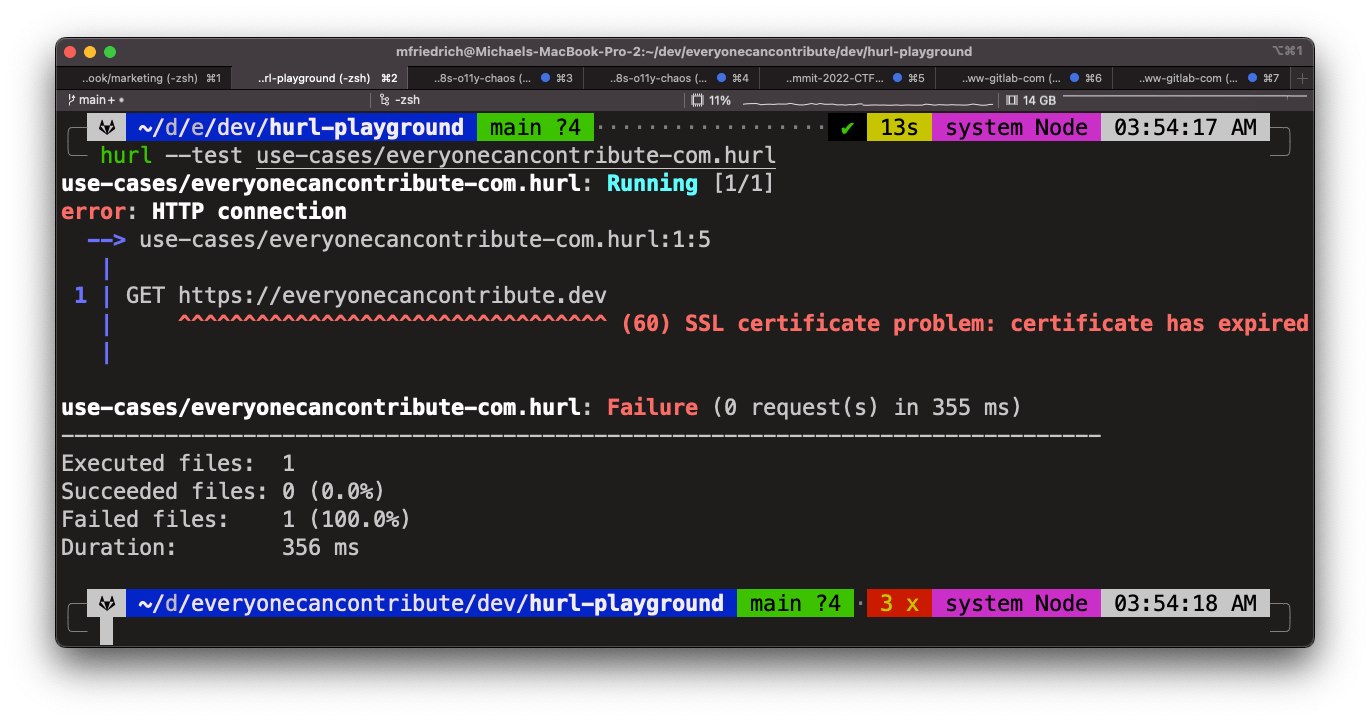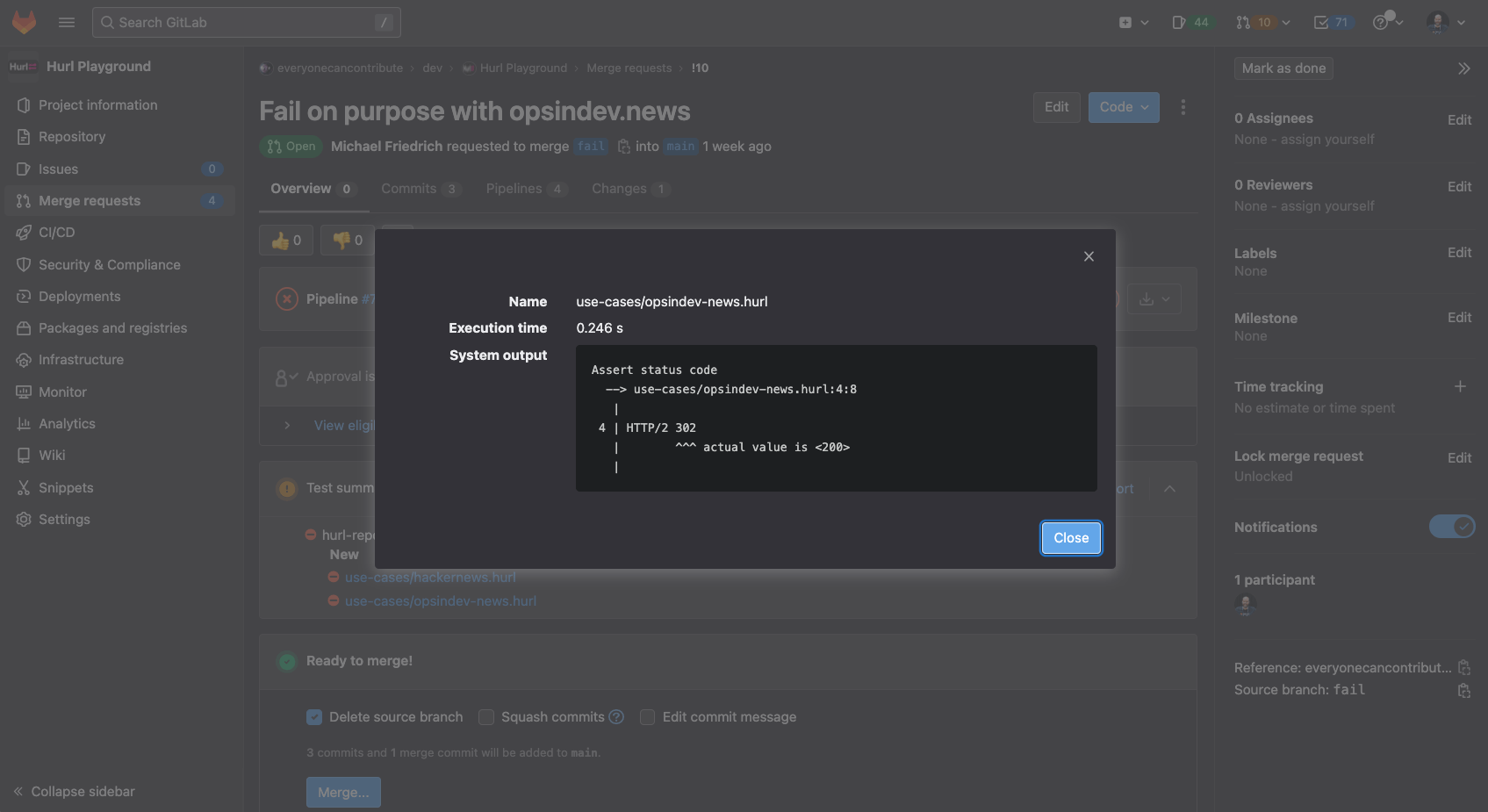Testing websites, web applications, or generally everything reachable with the HTTP protocol, can be a challenging exercise. Thanks to tools like curl and jq, DevOps workflows have become more productive and even simple monitoring tasks can be automated with CI/CD pipeline schedules. Sometimes, use cases require specialized tooling with custom HTTP headers, parsing expected responses, and building end-to-end test pipelines. Stressful incidents also need good and fast tools that help analyze the root cause and quickly mitigate and fix problems.
Hurl is an open-source project developed and maintained by Orange, and uses libcurl from curl to provide HTTP test capabilities. It aims to tackle complex HTTP test challenges by providing a simple plain text configuration to describe HTTP requests. It can chain requests, capture values, and evaluate queries on headers and body responses. So far, so good: Hurl does not only support fetching data, it can be used to test HTTP sessions and XML (SOAP) and JSON (REST) APIs.
Getting Started
Hurl comes in various package formats to install. On macOS, a Homebrew package is available.
$ brew install hurl
First steps with Hurl
Hurl proposes to start with the configuration file format first, which is a great way to learn the syntax step by step. The following example creates a new gitlab-contribute.hurl configuration file that will do two things: execute a GET HTTP request on https://about.gitlab.com/community/contribute/ and check whether its HTTP response contains the HTTP protocol 2 and status code 200 (OK).
$ vim gitlab-contribute.hurl
GET https://about.gitlab.com/community/contribute/
HTTP/2 200
$ hurl --test gitlab-contribute.hurl
gitlab-contribute.hurl: Running [1/1]
gitlab-contribute.hurl: Success (1 request(s) in 413 ms)
--------------------------------------------------------------------------------
Executed files: 1
Succeeded files: 1 (100.0%)
Failed files: 0 (0.0%)
Duration: 415 ms
Instead of creating configuration files, you can also use the echo “...” | hurl command pattern. The following command tests against about.gitlab.com and checks whether the HTTP response protocol is 1.1 and the status is OK (200). The two newline characters \n are required for separation.
$ echo "GET https://about.gitlab.com\n\nHTTP/1.1 200" | hurl --test

The command failed, and it says that the response protocol version is actually 2. Let's adjust the test run to expect HTTP/2:
echo "GET https://about.gitlab.com\n\nHTTP/2 200" | hurl --test
Asserting HTTP responses
Hurl allows defining assertions to control when the tests fail. These can be defined for different HTTP response types:
- Expected HTTP protocol version and status
- Headers
- Body
The configuration language allows users to define queries with predicates that allow to compare, chain, and execute different assertions.
This is the easiest way to verify that the HTTP response contains what is expected to be a string or sentence on the website, for example. If the string does not exist, this can indicate that it was changed unexpectedly, or that the website is down. Let's revisit the example with testing GET https://about.gitlab.com/community/contribute/ and add an expected string Everyone can contribute as a new assertion, body contains <string> is the expected configuration syntax for body asserts.
$ vim gitlab-contribute.hurl
GET https://about.gitlab.com/community/contribute/
HTTP/2 200
[Asserts]
body contains "Everyone should contribute"
$ hurl --test gitlab-contribute.hurl
Exercise: Fix the test by updating the asserts line to Everyone can contribute and run Hurl again.
Asserting responses: JSON and XML
JSONPath automatically parses the JSON response (a built-in jq with curl parser so to speak), and allows users to compare the value to verify the asserts (more below). The XML format can be found in an RSS feed on about.gitlab.com and parsed using XPath. The following example from atom.xml should be verified with Hurl:
<feed xmlns="http://www.w3.org/2005/Atom">
<title>GitLab</title>
<id>https://about.gitlab.com/blog</id>
<link href="https://about.gitlab.com/blog/"/>
<updated>2022-11-21T00:00:00+00:00</updated>
<author>
<name>The GitLab Team</name>
</author>
<entry>
...
</entry>
<entry>
...
</entry>
<entry>
…
It is important to note that XML namespaces need to be specified for parsing. Hurl allows users to replace the first default namespace with the _ character to avoid adding http://www.w3.org/2005/Atom everywhere, the XPath is now shorter with string(//_:feed/_:entry) to get a list of all entries. This value is captured in the entries variable, which can be compared to match a specific string, GitLab in this example. Additionally, the feed id and author name is checked.
$ vim gitlab-rss.hurl
GET https://about.gitlab.com/atom.xml
HTTP/2 200
[Captures]
entries: xpath "string(//_:feed/_:entry)"
[Asserts]
variable "entries" matches "GitLab"
xpath "string(//_:feed/_:id)" == "https://about.gitlab.com/blog"
xpath "string(//_:feed/_:author/_:name)" == "The GitLab Team"
$ hurl –test gitlab-rss.hurl
Hurl allows users to capture the value from responses into variables that can be used later. This method can also be helpful to model end-to-end testing workflows: First, check the website health status and retrieve a CSRF token, and then try to log into the website by sending the token again.
REST APIs that are expected to always return a specified field, or monitoring a website health state becomes a breeze using Hurl.
Use Hurl in GitLab CI/CD jobs
The easiest way to integrate Hurl into GitLab CI/CD is to use the official container image. The Hurl project provides a container image on Docker Hub, which did not work in CI/CD at first glance. After talking with the maintainers, the entrypoint override was identified as a solution for using the image in GitLab CI/CD. Note that the Alpine based image uses the libcurl library that does not support HTTP/2 yet - the test results are different to a Debian base image (follow this issue report for the problem analysis).
The following example is kept short to run the container image, override the entrypoint, and run Hurl with passing in the test using the echo CLI command.
hurl-standalone:
image:
name: ghcr.io/orange-opensource/hurl:latest
entrypoint: [""]
script:
- echo -e "GET https://about.gitlab.com/community/contribute/\n\nHTTP/1.1 200" | hurl --test --color
The Hurl test report is printed into the CI/CD job trace log, and returns succesfully.
$ echo -e "GET https://about.gitlab.com/community/contribute/\n\nHTTP/1.1 200" | hurl --test --color
-: Running [1/1]
-: Success (1 request(s) in 280 ms)
--------------------------------------------------------------------------------
Executed files: 1
Succeeded files: 1 (100.0%)
Failed files: 0 (0.0%)
Duration: 283 ms
Cleaning up project directory and file based variables
00:00
Job succeeded
The next iteration is to create a CI/CD job template that provides generic attributes, and allows users to dynamically run the job with an environment variable called HURL_URL.
# Hurl job template
.hurl-tmpl:
# Use the upstream container image and override the ENTRYPOINT to run CI/CD script
# https://docs.gitlab.com/ee/ci/docker/using_docker_images.html#override-the-entrypoint-of-an-image
image:
name: ghcr.io/orange-opensource/hurl:1.8.0
entrypoint: [""]
variables:
HURL_URL: "about.gitlab.com/community/contribute/"
script:
- echo -e "GET https://${HURL_URL}\n\nHTTP/1.1 200" | hurl --test --color
hurl-about-gitlab-com:
extends: .hurl-tmpl
variables:
HURL_URL: "about.gitlab.com/jobs/"
Running GET commands with expected HTTP results is not the only use case, and the Hurl maintainers thought about this already. The next section explains how to create a custom container image; you can skip to the DevSecOps workflows section to learn more about efficient Hurl configuration use cases.
Custom container image with Hurl
Maintaining and building a custom container image adds more work, but also helps with avoiding running unknown container images in CI/CD pipelines. The latter is often a requirement for compliance and security. Since the Hurl Debian package supports detecting HTTP/2 as a protocol, this blog post will focus on building a custom image, and run all tests using this image. If you plan on using the upstream container image, make sure to review the test configuration for the HTTP protocol version detection.
The Hurl documentation provides multiple ways to install Hurl. For this example, Debian 11 Bullseye (slim) is used. Hurl comes with a package dependency on libxml2 which can either be installed manually with then running the dpkg command, or by using apt install to install a local package and automatically resolve the dependencies.
The following CI/CD example uses a job template which defines the Hurl version as environment variable to avoid repetitive use, and downloads and installs the Hurl Debian package. The hurl-gitlab-com job extends the CI/CD job template and runs a one-line test against https://gitlab.com and expects to return HTTP/2 as HTTP protocol version, and 200 as status.
# CI/CD job template
.hurl-tmpl:
variables:
HURL_VERSION: 1.8.0
before_script:
- DEBIAN_FRONTEND=noninteractive apt update && apt -y install jq curl ca-certificates
- curl -LO "https://github.com/Orange-OpenSource/hurl/releases/download/${HURL_VERSION}/hurl_${HURL_VERSION}_amd64.deb"
- DEBIAN_FRONTEND=noninteractive apt -y install "./hurl_${HURL_VERSION}_amd64.deb"
hurl-gitlab-com:
extends: .hurl-tmpl
script:
- echo -e "GET https://gitlab.com\n\nHTTP/2 200" | hurl --test --color
The next section describes how to optimize the CI/CD pipelines for more efficient schedules and runs to monitor websites and not waste too many resources and CI/CD minutes. You can also skip it and scroll down to more advanced Hurl examples in GitLab CI/CD.
CI/CD efficiency: Hurl container image
The installation steps for Hurl, and its dependencies, can waste resources and increase the pipeline job runtime every time. To make the CI/CD pipelines more efficient, we want to use a container image that already provides Hurl pre-installed. The following steps are required for creating a container image:
- Use Debian 11 Slim (FROM).
- Install dependencies to download Hurl (
curl,ca-certificates).jqis installed for convenience to access it from CI/CD commands when needed later. - Download the Hurl Debian package, and use
apt installto install its dependencies automatically. - Clear the apt lists cache to enforce apt update again, and avoid security issues.
- Hurl is installed into the PATH, specify the default command being run. This allows running the container without having to specify a command.
The steps to install the packages are separated for better readability; an optimization for the docker-build job can happen by chaining the RUN commands into one long command.
Dockerfile
FROM debian:11-slim
ENV DEBIAN_FRONTEND noninteractive
ARG HURL_VERSION=1.8.0
RUN apt update && apt install -y curl jq ca-certificates
RUN curl -LO "https://github.com/Orange-OpenSource/hurl/releases/download/${HURL_VERSION}/hurl_${HURL_VERSION}_amd64.deb"
# Use apt install to determine package dependencies instead of dpkg
RUN apt -y install "./hurl_${HURL_VERSION}_amd64.deb"
RUN rm -rf /var/lib/apt/lists/*
CMD ["hurl"]
Note that the HURL_VERSION variable can be overridden by passing the variable and value into the container build job later. It is intentionally not using an automated script that always uses the latest release to avoid breaking the behavior, and enforces a controlled upgrade cycle for container images in production.
On GitLab.com SaaS, you can include the Docker.gitlab-ci.yml CI/CD template which will automatically detect the Dockerfile file and start building the image using the shared runners, and push it to the GitLab container registry. For self-managed instances or own runners on GitLab.com SaaS, it is recommended to decide whether to use and setup Docker-in-Docker or Kaniko, Podman, or other container image build tools.
include:
- template: Docker.gitlab-ci.yml
To avoid running the Docker image build job every time, the job override definition specifies to run it manually. You can also use rules to choose when to run the job, only when a Git tag is pushed for example.
include:
- template: Docker.gitlab-ci.yml
# Change Docker build to manual non-blocking
docker-build:
rules:
- if: '$CI_COMMIT_REF_NAME == $CI_DEFAULT_BRANCH'
when: manual
allow_failure: true
Once the container image is pushed to the registry, navigate into Packages and Registries > Container Registries and inspect the tagged image. Copy the image path for the latest tagged version and use it for the image attribute in the CI/CD job configuration.
Hurl container image in GitLab CI/CD example
The full example uses the previously built container image, and specifies the default HURL_URL variable. This can later be overridden by job definitions.
Please note that the image URL registry.gitlab.com/everyonecancontribute/dev/hurl-playground:latest is only used for demo purposes and not actively maintained or updated.
include:
- template: Docker.gitlab-ci.yml
# Change Docker build to manual non-blocking
docker-build:
rules:
- if: '$CI_COMMIT_REF_NAME == $CI_DEFAULT_BRANCH'
when: manual
allow_failure: true
# Hurl job template
.hurl-tmpl:
image: registry.gitlab.com/everyonecancontribute/dev/hurl-playground:latest
variables:
HURL_URL: gitlab.com
# Hurl jobs that check websites
hurl-dnsmichi-at:
extends: .hurl-tmpl
variables:
HURL_URL: dnsmichi.at
script:
- echo -e "GET https://${HURL_URL}\n\nHTTP/1.1 200" | hurl --test --color
hurl-opsindev-news:
extends: .hurl-tmpl
variables:
HURL_URL: opsindev.news
script:
- echo -e "GET https://${HURL_URL}\n\nHTTP/2 200" | hurl --test --color
The CI/CD configuration can further be optimized:
- Create job templates that execute the same scripts and only differ in the
HURL_URLvariable. - Use Hurl configuration files that allow specifying variables on the CLI or as environment variables. More on this in the next section.
DevSecOps workflows with Hurl
Hurl allows users to describe HTTP instructions in a configuration file with the .hurl suffix. You can add the configuration files to Git, and review and approve changes in merge requests - with the changes run in CI/CD and reporting back any failures before merging.
Inspect the use-cases/ directory in the example project, and fork it to make changes and commit and run the CI/CD pipelines and reports. You can also clone the project and run the tree command in the terminal.
$ tree use-cases
use-cases
├── dnsmichi.at.hurl
├── gitlab-com-api.hurl
├── gitlab-contribute.hurl
└── hackernews.hurl
Hurl supports the glob option which collects all configuration files matching a specific pattern.

Chaining requests
Similar to CI/CD pipelines, jobs, and stages, testing HTTP endpoints with Hurl can require multiple steps. First, ping the website for being reachable, and then try parsing expected results. Separating the requirements into two steps helps to analyze errors.
- HTTP endpoint reachable, but expected string not in response - static website was changed, REST API misses a field, etc.
- HTTP endpoint is unreachable, don’t try to understand why the follow-up tests fail.
The following example first sends a ping probe to the dev instance, and a check towards the production environment in the second request.
$ vim use-cases/everyonecancontribute-com.hurl
GET https://everyonecancontribute.dev
HTTP/2 200
GET https://everyonecancontribute.com
HTTP/2 200
$ hurl --test use-cases/everyonecancontribute-com.hurl
In this scenario, the TLS certificate of the dev instance expired, and Hurl halts the test immediately.

Hurl reports as JUnit test reports
Treat website monitoring and web app tests as unit and end-to-end tests. The Hurl developers thought of that too - the CLI command provides different output options for the report: --report-junit <outputpath> integrates with GitLab JUnit report support into merge requests and pipeline views.
The following configuration generates a JUnit report file into the value of the HURL_JUNIT_REPORT variable. It exists to avoid typing the path three times. The Hurl tests are run from the use-cases/ directory using a glob pattern.
# Hurl job template
.hurl-tmpl:
image: registry.gitlab.com/everyonecancontribute/dev/hurl-playground:latest
variables:
HURL_URL: gitlab.com
HURL_JUNIT_REPORT: hurl_junit_report.xml
# Hurl tests from configuration file, generating JUnit report integration in GitLab CI/CD
hurl-report:
extends: .hurl-tmpl
script:
- hurl --test use-cases/*.hurl --report-junit $HURL_JUNIT_REPORT
after_script:
# Hack: Workaround for 'id' instead of 'name' in JUnit report from Hurl. https://gitlab.com/gitlab-org/gitlab/-/issues/299086
- sed -i 's/id/name/g' $HURL_JUNIT_REPORT
artifacts:
when: always
paths:
- $HURL_JUNIT_REPORT
reports:
junit: $HURL_JUNIT_REPORT
The JUnit format returned by Hurl 1.8.0 defines the id attribute, but the GitLab JUnit integration expects the name attribute to be present. While writing this blog post, the problem was discussed with the maintainers, and the name attribute was implemented and will be available in future releases. As a workaround with Hurl 1.8.0, the CI/CD after_script section uses sed to replace the attributes after generating the report.
The following example fails on purpose with checking a different HTTP protocol version.
GET https://opsindev.news
# This will fail on purpose
HTTP/1.1 200
[Asserts]
body contains "Michael Friedrich"

Once the JUnit integration with Hurl tests from a glob pattern work, you can continue adding new .hurl configuration files to the GitLab repository and start testing in MRs, which will require review and approval workflows for production then.
Web review apps
Website monitoring is only one aspect of using Hurl: Testing web applications deployed in review environments in the cloud, and in cloud-native clusters provides a native integration into DevSecOps workflows. The CI/CD pipelines will fail when Hurl tests are failing, and more insights are provided using merge request widgets reports.
Cloud Seed provides the ability to deploy a web application to a major cloud provider, for example Google Cloud. After the deployment is successful, additional CI/CD jobs can be configured that verify that the deployed web app version does not introduce a regression, and provides all required data elements, API endpoints, etc. A similar workflow can be achieved by using review app environments with webservers (Nginx, etc.), Docker, AWS, and Kubernetes. The review app environment URL is important for instrumenting the Hurl tests dynamically. The CI/CD variable CI_ENVIRONMENT_URL is available when environment:url is specified in the review app configuration.
The following example tests the review app for this blog post when written in a merge request:
# Test review apps with hurl for this blog post.
hurl-review-test:
extends: .review-environment # inherits the environment settings
needs: [uncategorized-build-and-review-deploy] # waits until the website (sites/uncategorized) is deployed
stage: test
rules: # YAML anchor that runs the job only on merge requests
- <<: *if-merge-request-original-repo
image:
name: ghcr.io/orange-opensource/hurl:1.8.0
entrypoint: [""]
script:
- echo -e "GET ${CI_ENVIRONMENT_URL}\n\nHTTP/1.1 200" | hurl --test --color
The environment is specified in the .review-environment job template and used to deploy the website review job. The relevant configuration snippet is shown here:
.review-environment:
variables:
DEPLOY_TYPE: review
environment:
name: review/$CI_COMMIT_REF_SLUG
url: https://$CI_COMMIT_REF_SLUG.about.gitlab-review.app
on_stop: review-stop
auto_stop_in: 30 days
The deployment of the www-gitlab-com project uses buckets in Google Cloud that serve the website content in the review app. There are different types of web applications that require different deployment methods - as long as the environment URL variable is available in CI/CD and the deployment URL is accessible from the GitLab Runner executing the CI/CD job, you can continously test web apps with Hurl!

Development tips
Use the --verbose parameter to see the full request and response flow. Hurl also provides tips which curl command could be run to fetch more data. This can be helpful when starting to use or develop a new REST API, or learning to understand the JSON structure of HTTP responses. Chaining the curl command with jq (the curl ... | jq pattern) can still be helpful to fetch data, and build the HTTP tests in a second terminal or editor window.
$ curl -s 'https://gitlab.com/api/v4/projects' | jq
$ curl -s 'https://gitlab.com/api/v4/projects' | jq -c '.[]' | jq
{"id":41375401,"description":"An example project for a GitLab pipeline.","name":"Calculator","name_with_namespace":"Iva Tee / Calculator","path":"calculator","path_with_namespace":"snufkins_hat/calculator","created_at":"2022-11-26T00:32:33.825Z","default_branch":"master","tag_list":[],"topics":[],"ssh_url_to_repo":"[email protected]:snufkins_hat/calculator.git","http_url_to_repo":"https://gitlab.com/snufkins_hat/calculator.git","web_url":"https://gitlab.com/snufkins_hat/calculator","readme_url":"https://gitlab.com/snufkins_hat/calculator/-/blob/master/README.md","avatar_url":null,"forks_count":0,"star_count":0,"last_activity_at":"2022-11-26T00:32:33.825Z","namespace":{"id":58849237,"name":"Iva Tee","path":"snufkins_hat","kind":"user","full_path":"snufkins_hat","parent_id":null,"avatar_url":"https://secure.gravatar.com/avatar/a3efe834950275380d5f19c9b17c922c?s=80&d=identicon","web_url":"https://gitlab.com/snufkins_hat"}}
The GitLab projects API returns an array of elements, where we can inspect the id and name attributes for a simple test - the first element’s name must not be empty, the second element’s id needs to be greater than 0.
$ vim gitlab-com-api.hurl
GET https://gitlab.com/api/v4/projects
HTTP/2 200
[Asserts]
jsonpath "$[0].name" != ""
jsonpath "$[1].id" > 0
$ hurl --test gitlab-com-api.hurl
gitlab-com-api.hurl: Running [1/1]
gitlab-com-api.hurl: Success (1 request(s) in 728 ms)
--------------------------------------------------------------------------------
Executed files: 1
Succeeded files: 1 (100.0%)
Failed files: 0 (0.0%)
Duration: 730 ms
More use cases
- Work with HTTP sessions and cookies, test forms with parameters.
- Review existing API tests of your applications.
- Build advanced chained workflows with GET, POST, PUT, DELETE, and more HTTP methods.
- Integrate simple ping/HTTP monitoring health checks into the DevSecOps Platform using alerts and incident management.
If the Hurl checks cannot be integrated directly inside the project where the application is developed and deployed, another idea could be to create a standalone GitLab project that has CI/CD pipeline schedules enabled. It can continuously run the Hurl tests, and parse the reports or trigger an event when the pipeline is failing, and create an alert by sending a JSON payload from the Hurl results to the HTTP endpoint. Developers can send MRs to update the Hurl tests, and maintainers review and approve the new test suites being rolled out into production. Alternatively, move the complete CI/CD configuration into a group/project with different permissions, and specify the CI/CD configuration as remote URL in the web application project. This compliance level helps to control who can make changes to important tests and CI/CD configuration.
Hurl supports --json as parameter to only return the JSON formatted test result and build own custom reports and integrations.
$ echo -e "GET https://about.gitlab.com/teamops/\n\nHTTP/2 200" | hurl --json | jq
For folks in DevRel, monitoring certain websites for keywords or checking APIs whether values increase a certain threshold can be interesting. Here is an example for monitoring Hacker News using the Algolia search API, inspired by the Zapier integration used for GitLab Slack. The QueryStringParams section allows users to define the query parameters as a readable list, which is easier to modify. The jsonpath checks searches for the hits key and its count being zero (not on the Hacker News front page means OK in this example).
$ vim hackernews.hurl
GET https://hn.algolia.com/api/v1/search
[QueryStringParams]
query: gitlab
#query: hurl
tags: front_page
HTTP/2 200
[Asserts]
jsonpath "$.hits" count == 0
$ hurl --test hackernews.hurl
Limitations
Hurl works great for testing websites and web applications that serve static content, and by sending different HTTP request types, data, etc., and ensuring that responses match expectations. Compared to other end-to-end testing solutions (Selenium, etc.), Hurl does not provide a JavaScript engine and only can parse the raw DOM or JSON response. It does not support a DOM managed and rendered by JavaScript front-end frameworks. UI integration tests also need to be performed with different tools, similar to full end-to-end test workflows. Other examples are accessibility testing and browser performance testing. If you are curious how end-to-end testing is done for GitLab, the product, peek into the development documentation.
Conclusion
Hurl provides an easy way to test HTTP endpoints (such as websites and APIs) in a fast and reliable way. The CLI commands can be integrated into CI/CD workflows, and the configuration syntax and files provide a single source of truth for everything. Additional support for JUnit report formats ensure that website testing is fully integrated into the DevSecOps platform, and increases visibility and extensibility with automating tests, and monitoring. There are known limitations with dynamic JavaScript websites and advanced UI/end-to-end testing workflows.
Hurl is open source, created and maintained by Orange, and written in Rust. This blog post inspired contributions to the Debian/Ubuntu installation documentation and default issue templates.
Tip: Practice using Hurl on the command line, and remember it when the next production incident shows a strange API behavior with POST requests.
Thanks to Lee Tickett who inspired me to test Hurl in GitLab CI/CD and write this blog post after seeing huge interest in a Twitter share.
Cover image by Aaron Burden on Unsplash



